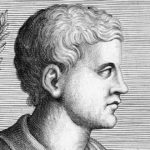. The Bible is the primary source documenting the unfolding revelation of God in His nature, His purposes and ways. Man cannot penetrate into the knowledge of God; instead human beings grope after Him (Acts 17:27) and this they do after a fashion, especially at times of great need. But we have need of much more than natural revelation, we must have that special uncovering God chooses to give when He causes the light to shine into the darkness of our heart and this is supremely in the face of Jesus Christ (2 Corinthians 4:6). Although revelation from God can be of the nature of something sudden, like a flash of lightening, it is also very much like the process of the passing from the darkness of night to the brightness of the dawn. Thus it should be taking place in our hearts as continuing experience and will include the ‘death of God,’ that is, the dissolution of the corrupted and idolatrous ways that we, in our ignorance, construed Him to be.
If I were to write that God is ‘useless’ immediately many would react in horror. But if we write into God our own sense of values we must own up to the fact that we always think in a utilitarian way. What is it used for? What does it give us? What will I get out of it? All these and more questions like them underlie the deep attitudes of the heart and as we consider God we tend to ask what He can do for us, what we can get out of Him, He becomes a kind of ‘salvation machine,’ an object of use to benefit our own self. Yet, this is not the Biblical revelation. God is life, He is, He changes not, He is the God Who is ‘there’ and never away, immanent, present whilst at the same time being transcendent Creator and faithful provider for all that He has made. God is the life-giver and the sustainer of every creature, “in Him we live and move and have our being,” “He is not far from every one of us,” “He gives to all life, breath and all things” (Acts 17:25-28). Prayer is not a matter of a list of things we desire Him to accomplish for us so much as a life lived in the context of God as ever present, ceaselessly at work and fulfilling His eternal purposes in every part of His creation. He, Who is, dwells everywhere. He Who sits enthroned rules over all things, even when enemies appear to be winning the day.
The Bible is filled with God’s self-revelation. Abraham was a pagan idolater; when older in years the God of glory appeared to him; he was forever changed and his life took a completely different turn (Genesis 12:1-3, Acts 7:2). Revelation is the act of unveiling, the removal of the covering that kept something hidden from view. Abraham had not known the true nature and being of God and this revelation of Him as God of glory must be taken in contrast to the deities he had worshipped in his earlier life, gods of shame, crude, corrupt and corrupting their worshippers. Worship of these false deities did not ennoble but debauched those who adored them. False deities always do that to their worshippers. Those to whom God reveals Himself are changed deeply and so it was with Abraham as he began the pilgrimage during which the God Who had appeared unto him disclosed Himself in further ways as he went along obediently. Four hundred or so years after Abraham God showed Himself to Moses when he too was older in years. The story is famous, the bush that burned and was not consumed. Surely an apt way for God to make Himself known, for He Named Himself “I am that I am” (Exodus 3:14). What kind of Name is this? Obscure maybe to some of us at first, but think of the context. Moses was a Jew, and for Him and his forefathers God was the fundamental secret of their identity and destiny as a nation; He was their whole background. God had spoken: He had promised and yet had seemingly disappeared from their history, the children of Abraham, Isaac and Jacob were now serving as slaves to tyrannous overlords, the promises had failed and suddenly He appears and announces Himself as “I AM THAT I AM.” The revelation implicit in this Name is that He has always been there, no change at all; involved in everything that has been taking place in their history though hidden from their view. Now He comes into sight, indeed He burns unquenchably in His purposes; just like the bush constantly afire and not consumed. We reverently can say that God does not ‘go out!’
The Epistle to the Hebrews (the nation of Abraham and Moses among others) commences with a majestic paragraph (Hebrews 1:1-4). God revealed Himself to the fathers in various ways, a little here and a little there, but in these last days He sent His Son. Jesus is God’s last word to mankind; every earlier revelation led up to Him and beyond Him there is no other. In Him the Life that is “I AM THAT I AM” was revealed (John 1:4 & John 1:18). No wonder those who distorted the image of God hounded Jesus to the death (Mark 14:1). They wanted a manageable deity made in their own likeness. Someone they could manipulate with sacrifices and tithes and offerings. Jesus had come challenging their idolatrous concepts of God by BEING THE SON and so revealing God as HE IS. No wonder when He bore testimony He did so using the words “I AM” and it was those very words that made His pathway to Calvary a certainty (Mark 14:62). God is life and the life of all things. God is living and His Son Jesus says, “I am the way, the truth and the life” (John 14:6). To be living means to be in movement. How Jesus loved to use analogies of living things in His parables. The seed cast upon the ground and growing, the vine and its branches, the flowing of rivers; He spoke of families and children not organizations and systems. That which had built up falsely in the temple He cast out; the money-changers and others profiteering in their misuse of His Father’s House and His Father’s things came under His ban. Religious distortions of God were on every side. In much of the religion and worship of the day, God, the Life of all things had become a rigid form without speech or breath and it was inevitable that the death of this god formed over years must take place. It was a forgone conclusion that Jesus, in Whom was the Life and Who came to bring abundant life (John 10:10) would challenge these twisted ideas of God to the death.
Jesus reinterpreted God in virtually everything He did and said. His parables are iconoclastic especially. Among the most famous is that of the father and his two sons (Luke 15:11-32). He redefines sin in the story of the lost sheep, lost coin and lost sons. The religious leaders of His day thought of sin as certain deeds for which there were fixed penalties whereas Jesus thinks more of sins effects and the broken relationship with God as Shepherd of the flock He loves, the woman as owner of coins that mean so much to her and the father whose two sons had little or no relationship with him. These stories are shot through with the thought of the restoration of rightful relationships and they are especially beautiful in that regard. The chapter concludes with the story of God as Father saying to the older boy, “Son you are ever with me, and all that I have is yours. It was right that we should make merry and be glad, for this your brother was dead and is alive and was lost and is found (Luke 15:31-32). The older son had never been away from his father, but alas, he had lived neither knowing him or his true nature and presence. So near and yet so far; living in the house, serving (note the word) on the farm, going about his daily chores, perhaps sitting down at table but, to him, the father was an unknown as to his essential being. If we take this story in its immediate historical context we can interpret the younger of the two sons as representing the failed ten tribes who went away into captivity seven hundred years earlier and were still far off. The older son would then be the southern Kingdom who had gone into Babylon six centuries earlier and had returned after seventy years and re-established the worship of God, a worship that had become for many incredibly rigid and deadly. They had ‘stayed home’ with God and we can see the tenderness and truth of God the Father as Jesus speaks to these who had formalized God and reshaped Him after the fashion of their own minds, “Son, you are ever with Me, and all that I have is yours.” “I have never left you, you are Mine.” You have been living, moving and having your being in Me but you have not known Me.” “You have been living in a spiritual correctness and have been judgmental of others.” “Let your misconceptions about Me come to death and allow Me to show Myself to you.” “Live in Me, in the midst of things, they are all yours (1 Corinthians 3:22). “The world, life, or death, or things present, or things to come: all are yours and you are Christ’s and Christ is God’s.” The prayerful person is responsive and alive to God in the midst of things. He is to be found everywhere and in this continuing and increasing knowledge of Him the death of every misconception about Him is sure to occur.




